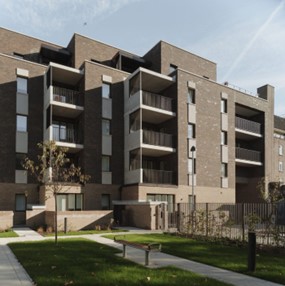Indoor Thermal Comfort
Area: Design, planning and building
Improving indoor thermal comfort is a widely agreed motivate for housing retrofit (Femenías et al., 2018; Outcault et al., 2022; Sojkova et al., 2019; Zahiri & Elsharkawy, 2018). Low carbon retrofit of existing social housing tends to be driven by cost, the use of eco-friendly products, and energy savings (Sojkova et al., 2019). Energy savings are particularly important in colder climates where households require larger energy loads for space heating and thermal comfort and are therefore at greater risk of fuel (energy) poverty (Sojkova et al., 2019; Zahiri & Elsharkawy, 2018). Femenías et al.’s (2018) extensive literature review on property owners’ attitudes to energy efficiency argues that renovations are typically motivated by other needs, referred to by Outcault et al (2022) as ‘non-energy impacts’ (NEIs). While lists of NEIs are inconsistent in the literature, categories related to “weatherization retrofit” (Outcault et al., 2022, p.3) refer to comfort, modernity, health, safety, education, and better indoor air quality (Amann, 2006; Bergman & Foxon, 2020; Broers et al., 2022; Outcault et al., 2022). In poorly maintained social housing, however, the desire to improve indoor air quality and thermal comfort will have an impact on energy consumption. Occupants will, for example, use extra heating to feel comfortable in a damp, mouldy, or cold home. (Zahiri & Elsharkawy, 2018).
There are three main technical improvements to low carbon retrofit: (1) enhancing the building fabrics thermal properties; (2) improving systems efficiency; and (3) renewable energy integration (Institute for Sustainability & UCL Energy Institute, 2012). In order for the Passivehaus Institut’s EnerPHit Retrofit Plan to meet Passivhaus standards for indoor air quality, homes must achieve high levels of air tightness complemented by a mechanical ventilation system including heat recovery (MVHR). Specifically, “airtightness of a building must achieve an air change per hour rate of less than 0.6 at 50 Pa of pressure (n50), and have ventilation provided by either a balanced mechanical heat recovery ventilation or demand-controlled ventilation systems” (McCarron et al., 2019, p.297). This airtightness concept is revered for saving energy, avoiding structural damage, and contributing to thermal comfort (Bastian et al., 2022) while requiring no natural ventilation such as open windows. Mechanical HVAC units alter indoor air temperature, air movement, ventilation, noise levels, and humidity (Outcault et al., 2022). But despite known benefits to physical health and clean air, this may not lead to optimum user-comfort. This is because social housing residents have unique housing needs that differ from homeowners (Sunikka-Blank et al., 2018) and cannot be predicted without resident engagement, as residents are experts in the way they live and use their homes (Boess, 2022; Gianfrate et al., 2017; Walker et al., 2014).
Post Occupancy Evaluation after retrofit has found that social housing residents are often unfamiliar with mechanical systems and their sustainable benefits, especially when retrofit occurs without resident input (Garnier et al., 2020). This can lead to misuse, overheating, the prebound effect, and the rebound effect where affordable energy bills lead to excessive heating—at times 25-26°C (Zoonnekindt, 2019)—contributing to performance gaps as high as five times the predicted energy consumption (Traynor, 2019). Other households considered mechanical systems to be bulky, ugly, and noisy, prompting removal, lack of use, and at times emotional distress (Lowe et al., 2018). DREEAM’s Berlin pilot site found one household blocking mechanical ventilation with tissue paper because they considered the air too cold and residents “haven’t been informed about the positive impact of a well working ventilation on their health and on the energy efficiency of the heating in their apartment” (Zoonnekindt, 2019). DREEAM continued the project with Green Neighbours (Zoonnekindt, 2019), an innovative engagement program co-designed with and for residents to better inform mechanical systems usage. However, literature shows (Boess, 2022; Gianfrate et al., 2017; Walker et al., 2014) that informing residents on how to use mechanical systems is unlikely to change use-habits or adequately combat performance gaps. In order to change residents’ energy behaviours, resident stakeholders should be integrated in retrofit decision-making.
References
Amann, J. T. (2006). Valuation of Non-Energy Benefits to Determine Cost-Effectiveness of Whole-House Retrofits Programs: A Literature Review. http://aceee.org
Bastian, Z., Schnieders, J., Conner, W., Kaufmann, B., Lepp, L., Norwood, Z., Simmonds, A., & Theoboldt, I. (2022). Retrofit with Passive House components. Energy Efficiency, 15(1). https://doi.org/10.1007/s12053-021-10008-7
Bergman, N., & Foxon, T. J. (2020). Reframing policy for the energy efficiency challenge: Insights from housing retrofits in the United Kingdom. Energy Research and Social Science, 63. https://doi.org/10.1016/j.erss.2019.101386
Broers, W., Kemp, R., Vasseur, V., Abujidi, N., & Vroon, Z. (2022). Justice in social housing: Towards a people-centred energy renovation process. Energy Research and Social Science, 88. https://doi.org/10.1016/j.erss.2022.102527
Boess, S. (2022). Let’s Get Sociotechnical: A Design Perspective on Zero Energy Renovations. Urban Planning, 7(2), 97–107. https://doi.org/10.17645/up.v7i2.5107
Femenías, P., Mjörnell, K., & Thuvander, L. (2018). Rethinking deep renovation: The perspective of rental housing in Sweden. Journal of Cleaner Production, 195, 1457–1467. https://doi.org/10.1016/j.jclepro.2017.12.282
Garnier, S., Pittini, A., del Pero, C., & Vallan, A. (2020). HEART D9.9 - Evaluation of building users’ acceptance and satisfaction - I.
Gianfrate, V., Piccardo, C., Longo, D., & Giachetta, A. (2017). Rethinking social housing: Behavioural patterns and technological innovations. Sustainable Cities and Society, 33, 102–112. https://doi.org/10.1016/j.scs.2017.05.015
Institute for Sustainability, & UCL Energy Institute. (2012). Retrofit strategies. Key Findings: Retrofit project team perspectives. https://www.instituteforsustainability.co.uk/uploads/File/2236_KeySummary03.pdf
Lowe, R., Chiu, L. F., & Oreszczyn, T. (2018). Socio-technical case study method in building performance evaluation. Building Research and Information, 46(5), 469–484. https://doi.org/10.1080/09613218.2017.1361275
McCarron, B., Meng, X., & Colclough, S. (2019). A pilot study of radon levels in certified passive house buildings. Building Services Engineering Research and Technology, 40(3), 296–304. https://doi.org/10.1177/0143624418822444
Outcault, S., Sanguinetti, A., Dessouky, N., & Magaña, C. (2022). Occupant Non-Energy Impact Identification Framework: A human-centered approach to understanding residential energy retrofits. Energy and Buildings, 263, 112054. https://doi.org/10.1016/j.enbuild.2022.112054
Sojkova, K., Volf, M., Lupisek, A., Bolliger, R., & Vachal, T. (2019). Selection of favourable concept of energy retrofitting solution for social housing in the Czech Republic based on economic parameters, greenhouse gases, and primary energy consumption. Sustainability (Switzerland), 11(22). https://doi.org/10.3390/su11226482
Sunikka-Blank, M., Galvin, R., & Behar, C. (2018). Harnessing social class, taste and gender for more effective policies. Building Research and Information, 46(1), 114–126. https://doi.org/10.1080/09613218.2017.1356129
Traynor, J. (2019). ENERPHIT: A step by step guide to low energy retrofit. RIBA Publishing.
Walker, S. L., Lowery, D., & Theobald, K. (2014). Low-carbon retrofits in social housing: Interaction with occupant behaviour. Energy Research and Social Science, 2, 102–114. https://doi.org/10.1016/j.erss.2014.04.004
Zahiri, S., & Elsharkawy, H. (2018). Towards energy-efficient retrofit of council housing in London: Assessing the impact of occupancy and energy-use patterns on building performance. Energy and Buildings, 174, 672–681. https://doi.org/10.1016/j.enbuild.2018.07.010
Zoonnekindt, K. (2019). DREEAM scaling energy renovation: Final analysis on the tenants engagement and communication strategies 4.8. https://dreeam.eu/wp-content/uploads/2020/09/D.4.8_Final-analysis-on-tenants-engagement-and-communication-strategies-compressed.pdf
Created on 20-09-2022 | Update on 23-10-2024
Related definitions
Housing Retrofit
Area: Design, planning and building
Created on 16-02-2022 | Update on 23-10-2024
Read more ->Participatory Approaches
Area: Community participation
Created on 17-02-2022 | Update on 23-10-2024
Read more ->Energy Retrofit
Area: Design, planning and building
Created on 23-05-2022 | Update on 23-10-2024
Read more ->Just Transition
Area: Policy and financing
Created on 03-06-2022 | Update on 23-10-2024
Read more ->Social Sustainability
Area: Community participation
Created on 03-06-2022 | Update on 23-10-2024
Read more ->Sustainability
Area: Community participation
Created on 08-06-2022 | Update on 23-10-2024
Read more ->Social Housing
Area: Policy and financing
Created on 17-06-2023 | Update on 23-10-2024
Read more ->Techno-optimism
Area: Design, planning and building
Created on 14-10-2024 | Update on 07-11-2024
Read more ->Thermal Insulation & Airtightness
Area: Design, planning and building
Created on 25-10-2024 | Update on 08-11-2024
Read more ->Related cases

Knight’s Walk (Lambeth's Homes)
Created on 26-07-2024

